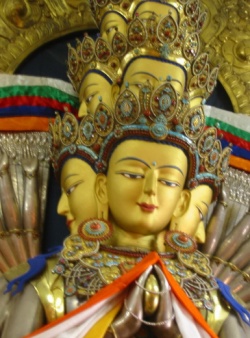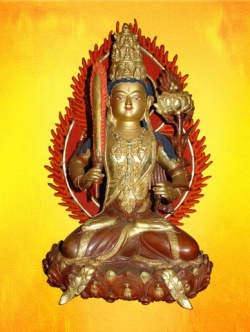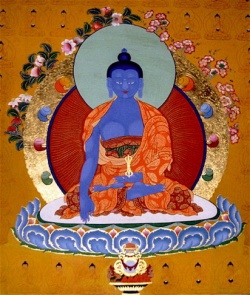Difference between revisions of "Buddha Bodhisattva Directory"
m (1 revision: Robo replace 16sept) |
|||
| Line 1: | Line 1: | ||
[[File:8O3temple.jpg|thumb|250px|]] | [[File:8O3temple.jpg|thumb|250px|]] | ||
<poem> | <poem> | ||
| − | Sakyamuni (the [[historical Buddha]]) | + | [[Sakyamuni]] (the [[historical Buddha]]) |
| − | [[Maitreya]] (The future [[Buddha]]) | + | [[Maitreya]] (The {{Wiki|future}} [[Buddha]]) |
| − | According to the Tantric system, each of the five "[[Enlightened]]-Families" comprises a central male [[Buddha]], representing one of the purified [[Aggregates]]. Female [[Buddha]] representing one of the purified elements. | + | According to the [[Tantric]] system, each of the five "[[Enlightened]]-Families" comprises a central {{Wiki|male}} [[Buddha]], representing one of the [[purified]] [[Aggregates]]. {{Wiki|Female}} [[Buddha]] representing one of the [[purified]] [[elements]]. |
| − | [[Vairocana]] (male, head of [[Buddha]]-family) the purified aspect of our [[Aggregate]] of [[Consciousness]]/[[Form]] | + | [[Vairocana]] ({{Wiki|male}}, head of [[Buddha]]-[[family]]) the [[purified]] aspect of our [[Aggregate]] of [[Consciousness]]/[[Form]] |
| − | [[Akshobhya]] (male, head of [[Vajra]]-family) - the purified aspect of our [[Aggregate]] of [[Consciousness]]/[[Form]] | + | [[Akshobhya]] ({{Wiki|male}}, head of [[Vajra]]-[[family]]) - the [[purified]] aspect of our [[Aggregate]] of [[Consciousness]]/[[Form]] |
| − | [[Ratnasambhava]] (male, head of ratna-family) - the purified aspect of our [[Aggregate]] of [[Feeling]] | + | [[Ratnasambhava]] ({{Wiki|male}}, head of ratna-family) - the [[purified]] aspect of our [[Aggregate]] of [[Feeling]] |
| − | [[Amitabha]] (male, head of padma-family) - the purified aspect of our [[Aggregate]] of [[Perception]]/discrimination | + | [[Amitabha]] ({{Wiki|male}}, head of padma-family) - the [[purified]] aspect of our [[Aggregate]] of [[Perception]]/{{Wiki|discrimination}} |
| − | [[Amoghasiddhi]] (male, head of [[Karma]]-family) - the purified aspect of our [[Aggregate]] of conditioning and motivational factors. | + | [[Amoghasiddhi]] ({{Wiki|male}}, head of [[Karma]]-[[family]]) - the [[purified]] aspect of our [[Aggregate]] of {{Wiki|conditioning}} and motivational factors. |
| Line 16: | Line 16: | ||
[[Avalokitesvara]] (The deepest [[Compassion]]) | [[Avalokitesvara]] (The deepest [[Compassion]]) | ||
[[Manjushri]] (The most profound [[Wisdom]]) | [[Manjushri]] (The most profound [[Wisdom]]) | ||
| − | [[Samantabhadra]] (The most dedicated practice) | + | [[Samantabhadra]] (The most dedicated [[practice]]) |
| − | [[Ksitigarbha]] (The vow to reach the lowest) | + | [[Ksitigarbha]] (The [[vow]] to reach the lowest) |
| − | Meditational Deity | + | [[Meditational Deity]] |
[[Avalokiteshvara]] | [[Avalokiteshvara]] | ||
[[Cakrasamvara]] | [[Cakrasamvara]] | ||
| − | Also known as Heruka, Cakrasamrara is a meditational deity of the [[Anuttarayogatantra]] class. The study and practice of this [[Tantra]] is widespread in the [[Kagyu]], Sakya and [[Gelug]] traditions of Tibetan Buddhis m, while related forms known as Buddhasamayoga and Shriheruka are well-known wit hin [[The Nyingma Tradition]]. | + | Also known as [[Heruka]], Cakrasamrara is a [[meditational deity]] of the [[Anuttarayogatantra]] class. The study and [[practice]] of this [[Tantra]] is widespread in the [[Kagyu]], [[Sakya]] and [[Gelug]] [[traditions]] of [[Tibetan]] [[Buddhis]] m, while related [[forms]] known as Buddhasamayoga and [[Shriheruka]] are well-known wit hin [[The Nyingma Tradition]]. |
[[File:Akasagarbha14.jpg|thumb|250px|]] | [[File:Akasagarbha14.jpg|thumb|250px|]] | ||
| − | Cintamani [[Tara]] | + | [[Cintamani]] [[Tara]] |
| − | A specific meditational practice of the female deity Green [[Tara]]. Cintamani belongs to the [[Anuttarayogatantra]] class, and so includes both the generation/creation stage and th e completion/perfection stage of tantric [[Meditation]]. This practice is popular mainly in the [[Gelug]] tradition of [[Tibetan Buddhism]]. | + | A specific [[meditational practice]] of the {{Wiki|female}} [[deity]] Green [[Tara]]. [[Cintamani]] belongs to the [[Anuttarayogatantra]] class, and so includes both the generation/creation stage and th e completion/perfection stage of [[tantric]] [[Meditation]]. This [[practice]] is popular mainly in the [[Gelug]] [[tradition]] of [[Tibetan Buddhism]]. |
| − | Damtsig [[Dorje]] | + | [[Damtsig]] [[Dorje]] |
| − | A meditational deity specifically related to the practice of restoring broken commitments and pledges of the tantric [[Path]], by those holding tantric vows. | + | A [[meditational deity]] specifically related to the [[practice]] of restoring broken [[commitments]] and pledges of the [[tantric]] [[Path]], by those holding [[tantric vows]]. |
| − | Guhyasamaja | + | [[Guhyasamaja]] |
| − | Name of a principal meditational deity and [[Tantra]] text, representative of Mahayoga, according to the [[Nyingma]] school, and of the father [[Tantra]] class of [[Anuttarayogatantra]], according to the [[Sarma]] schools. | + | [[Name]] of a [[principal]] [[meditational deity]] and [[Tantra]] text, representative of [[Mahayoga]], according to the [[Nyingma]] school, and of the father [[Tantra]] class of [[Anuttarayogatantra]], according to the [[Sarma]] schools. |
| − | Hayagriva | + | [[Hayagriva]] |
| − | The teachings and texts associated with Hayagriva belong within the sadhana class of Mahayoga, as practiced by the [[Nyingma]] school, where they are known as the [[Tantras]] of [[Buddha]]- speech. Hayagriva is considered to be a wrathful manifestation of [[Avalokiteshvara]]. | + | The teachings and texts associated with [[Hayagriva]] belong within the [[sadhana class]] of [[Mahayoga]], as practiced by the [[Nyingma]] school, where they are known as the [[Tantras]] of [[Buddha]]- [[speech]]. [[Hayagriva]] is considered to be a [[wrathful]] [[manifestation]] of [[Avalokiteshvara]]. |
| − | Heruka, Yamantaka, Vajrabhairava ("Adamantine Rage") | + | [[Heruka]], [[Yamantaka]], [[Vajrabhairava]] ("[[Adamantine]] [[Rage]]") |
| − | It comprises all wrathful meditational deity and is interpreted in Tibetan as 'blood-drinking hero'. Heruka refers to the deity Shriheruka, [[Cakrasamvara]] or Paramasukha. | + | It comprises all [[wrathful]] [[meditational deity]] and is interpreted in [[Tibetan]] as 'blood-drinking [[hero]]'. [[Heruka]] refers to the [[deity]] [[Shriheruka]], [[Cakrasamvara]] or Paramasukha. |
| − | Hevajra | + | [[Hevajra]] |
| − | One of the principal meditational deities and [[Tantra]] texts of the mother class of [[Anuttarayogatantra]], the practice of which is dominant in the Sakya school of [[Tibetan Buddhism]]. | + | One of the [[principal]] [[meditational deities]] and [[Tantra]] texts of the [[mother class]] of [[Anuttarayogatantra]], the [[practice]] of which is dominant in the [[Sakya school]] of [[Tibetan Buddhism]]. |
| − | Jinasagara | + | [[Jinasagara]] |
| − | An aspect of the meditational deity [[Avalokiteshvara]]. | + | An aspect of the [[meditational deity]] [[Avalokiteshvara]]. |
| − | The practice of this particular [[Tantra]] belongs to the [[Anuttarayogatantra]]. In some translations, the [[Sanskrit]] [[Form]] has sometimes been reconstructed as jinasamudra. | + | The [[practice]] of this particular [[Tantra]] belongs to the [[Anuttarayogatantra]]. In some translations, the [[Sanskrit]] [[Form]] has sometimes been reconstructed as jinasamudra. |
[[File:Akshobhya14k.jpg|thumb|250px|]] | [[File:Akshobhya14k.jpg|thumb|250px|]] | ||
| − | Kalacakra | + | [[Kalacakra]] |
| − | One of the most well-known meditational deities of [[Anuttarayogatantra]]. | + | One of the most well-known [[meditational deities]] of [[Anuttarayogatantra]]. |
| − | [[Nechung]] (Protector Deity) | + | [[Nechung]] ([[Protector Deity]]) |
| − | One of the main protector deities of Tibet and of the [[Dalai Lama]]. The deity's medium is the state oracle of Tibet who is consulted on many important matters of state. | + | One of the main [[protector deities]] of [[Tibet]] and of the [[Dalai Lama]]. The [[deity's]] {{Wiki|medium}} is the [[state oracle of Tibet]] who is consulted on many important matters of [[state]]. |
| − | Ritroma | + | [[Ritroma]] |
| − | A female meditational deity associated with practices related to the [[Healing]] of certain illnesses. | + | A {{Wiki|female}} [[meditational deity]] associated with practices related to the [[Healing]] of certain [[illnesses]]. |
[[Tara]] | [[Tara]] | ||
| − | A female meditational deity who is regarded as the embodiment of all the [[Buddhas]]' [[Enlightened]] activity. There are many different aspects of [[Tara]], and the most popular of these are Green [[Tara]] (mainly associated with protection) and White [[Tara]] (often associated with [[Healing]] and longevity practices). Practices associated with [[Tara]] are widespread among all the four main traditions of [[Tibetan Buddhism]]. | + | A {{Wiki|female}} [[meditational deity]] who is regarded as the [[embodiment]] of all the [[Buddhas]]' [[Enlightened]] [[activity]]. There are many different aspects of [[Tara]], and the most popular of these are Green [[Tara]] (mainly associated with [[protection]]) and White [[Tara]] (often associated with [[Healing]] and longevity practices). Practices associated with [[Tara]] are widespread among all the four main [[traditions]] of [[Tibetan Buddhism]]. |
Vajrakrodhakala | Vajrakrodhakala | ||
| − | A wrathful male deity associated with the practice of Chod in [[The Nyingma Tradition]]. | + | A [[wrathful]] {{Wiki|male}} [[deity]] associated with the [[practice of Chod]] in [[The Nyingma Tradition]]. |
Vajrakrodhikali | Vajrakrodhikali | ||
| − | A wrathful female deity associated with the practice of Chod in the Nyingrna tradition. | + | A [[wrathful]] {{Wiki|female}} [[deity]] associated with the [[practice of Chod]] in the Nyingrna [[tradition]]. |
| − | Vajrakila | + | [[Vajrakila]] |
| − | The [[Tantras]] of Vajrakila are contained in the sadhana class of Mahayoga, and preserved in the COLLECTED [[Tantras]] OF THE [[Nyingmapa]]. Only one small fragment, translated by [[Sakya Pandita]], is to be found in the KANGYUR. A version of longer VAJRAKILA [[Tantras]] is also found in Chinese translations from the [[Sanskrit]]. | + | The [[Tantras]] of [[Vajrakila]] are contained in the [[sadhana class]] of [[Mahayoga]], and preserved in the COLLECTED [[Tantras]] OF THE [[Nyingmapa]]. Only one small fragment, translated by [[Sakya Pandita]], is to be found in the KANGYUR. A version of longer VAJRAKILA [[Tantras]] is also found in {{Wiki|Chinese}} translations from the [[Sanskrit]]. |
[[Vajrasattva]] | [[Vajrasattva]] | ||
| − | [[Vajrasattva]] is credited with the transmission of [[Atiyoga]] into the human [[World]]. It is an aspect of [[Akshobhya]], the deity associated with the [[Vajra]] family. There are many sadhanas dedicated to [[Vajrasattva]], and their practice is popular among all four schools of [[Tibetan Buddhism]]. | + | [[Vajrasattva]] is credited with the [[transmission]] of [[Atiyoga]] into the [[human]] [[World]]. It is an aspect of [[Akshobhya]], the [[deity]] associated with the [[Vajra]] [[family]]. There are many [[sadhanas]] dedicated to [[Vajrasattva]], and their [[practice]] is popular among all [[four schools]] of [[Tibetan Buddhism]]. |
[[Vajravarahi]] | [[Vajravarahi]] | ||
| − | A female meditational deity who may appear as the central figure of the [[Mandala]] in her own right or as the consort of the meditational deity [[Cakrasamvara]], also known as Paramasukha. | + | A {{Wiki|female}} [[meditational deity]] who may appear as the central figure of the [[Mandala]] in her [[own]] right or as the [[consort]] of the [[meditational deity]] [[Cakrasamvara]], also known as Paramasukha. |
[[Vajrayogini]] | [[Vajrayogini]] | ||
| − | A female meditational deity belonging to the [[Anuttarayogatantra]]. The [[Meditative]] practice of this deity is popular in the [[Kagyu]], Sakya and [[Gelug]] schools and the most well known aspect of the deity is the one known as Kecari. | + | A {{Wiki|female}} [[meditational deity]] belonging to the [[Anuttarayogatantra]]. The [[Meditative]] [[practice]] of this [[deity]] is popular in the [[Kagyu]], [[Sakya]] and [[Gelug]] schools and the most well known aspect of the [[deity]] is the one known as Kecari. |
</poem> | </poem> | ||
{{R}} | {{R}} | ||
Latest revision as of 02:05, 24 October 2015
Sakyamuni (the historical Buddha)
Maitreya (The future Buddha)
According to the Tantric system, each of the five "Enlightened-Families" comprises a central male Buddha, representing one of the purified Aggregates. Female Buddha representing one of the purified elements.
Vairocana (male, head of Buddha-family) the purified aspect of our Aggregate of Consciousness/Form
Akshobhya (male, head of Vajra-family) - the purified aspect of our Aggregate of Consciousness/Form
Ratnasambhava (male, head of ratna-family) - the purified aspect of our Aggregate of Feeling
Amitabha (male, head of padma-family) - the purified aspect of our Aggregate of Perception/discrimination
Amoghasiddhi (male, head of Karma-family) - the purified aspect of our Aggregate of conditioning and motivational factors.
Bodhisattva
Avalokitesvara (The deepest Compassion)
Manjushri (The most profound Wisdom)
Samantabhadra (The most dedicated practice)
Ksitigarbha (The vow to reach the lowest)
Meditational Deity
Avalokiteshvara
Cakrasamvara
Also known as Heruka, Cakrasamrara is a meditational deity of the Anuttarayogatantra class. The study and practice of this Tantra is widespread in the Kagyu, Sakya and Gelug traditions of Tibetan Buddhis m, while related forms known as Buddhasamayoga and Shriheruka are well-known wit hin The Nyingma Tradition.
Cintamani Tara
A specific meditational practice of the female deity Green Tara. Cintamani belongs to the Anuttarayogatantra class, and so includes both the generation/creation stage and th e completion/perfection stage of tantric Meditation. This practice is popular mainly in the Gelug tradition of Tibetan Buddhism.
Damtsig Dorje
A meditational deity specifically related to the practice of restoring broken commitments and pledges of the tantric Path, by those holding tantric vows.
Guhyasamaja
Name of a principal meditational deity and Tantra text, representative of Mahayoga, according to the Nyingma school, and of the father Tantra class of Anuttarayogatantra, according to the Sarma schools.
Hayagriva
The teachings and texts associated with Hayagriva belong within the sadhana class of Mahayoga, as practiced by the Nyingma school, where they are known as the Tantras of Buddha- speech. Hayagriva is considered to be a wrathful manifestation of Avalokiteshvara.
Heruka, Yamantaka, Vajrabhairava ("Adamantine Rage")
It comprises all wrathful meditational deity and is interpreted in Tibetan as 'blood-drinking hero'. Heruka refers to the deity Shriheruka, Cakrasamvara or Paramasukha.
Hevajra
One of the principal meditational deities and Tantra texts of the mother class of Anuttarayogatantra, the practice of which is dominant in the Sakya school of Tibetan Buddhism.
Jinasagara
An aspect of the meditational deity Avalokiteshvara.
The practice of this particular Tantra belongs to the Anuttarayogatantra. In some translations, the Sanskrit Form has sometimes been reconstructed as jinasamudra.
Kalacakra
One of the most well-known meditational deities of Anuttarayogatantra.
Nechung (Protector Deity)
One of the main protector deities of Tibet and of the Dalai Lama. The deity's medium is the state oracle of Tibet who is consulted on many important matters of state.
Ritroma
A female meditational deity associated with practices related to the Healing of certain illnesses.
Tara
A female meditational deity who is regarded as the embodiment of all the Buddhas' Enlightened activity. There are many different aspects of Tara, and the most popular of these are Green Tara (mainly associated with protection) and White Tara (often associated with Healing and longevity practices). Practices associated with Tara are widespread among all the four main traditions of Tibetan Buddhism.
Vajrakrodhakala
A wrathful male deity associated with the practice of Chod in The Nyingma Tradition.
Vajrakrodhikali
A wrathful female deity associated with the practice of Chod in the Nyingrna tradition.
Vajrakila
The Tantras of Vajrakila are contained in the sadhana class of Mahayoga, and preserved in the COLLECTED Tantras OF THE Nyingmapa. Only one small fragment, translated by Sakya Pandita, is to be found in the KANGYUR. A version of longer VAJRAKILA Tantras is also found in Chinese translations from the Sanskrit.
Vajrasattva
Vajrasattva is credited with the transmission of Atiyoga into the human World. It is an aspect of Akshobhya, the deity associated with the Vajra family. There are many sadhanas dedicated to Vajrasattva, and their practice is popular among all four schools of Tibetan Buddhism.
Vajravarahi
A female meditational deity who may appear as the central figure of the Mandala in her own right or as the consort of the meditational deity Cakrasamvara, also known as Paramasukha.
Vajrayogini
A female meditational deity belonging to the Anuttarayogatantra. The Meditative practice of this deity is popular in the Kagyu, Sakya and Gelug schools and the most well known aspect of the deity is the one known as Kecari.


